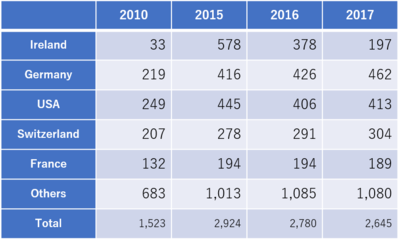Column Finance and the Social Security System 2020.01.15
【Aging, safety net and fiscal crisis in Japan】No.207: The trade deficit of the medical industry fell by 9.9% in 2017; however, it still remains large.
The trade deficit of the medical industry fell by 9.9% in 2017; however, it still remains large.
As mentioned in Column No. 151, the trade deficit of pharmaceuticals and medical devices has increased from 743 billion yen (USD 7 billion) in 2002, to 2,960 billion yen (USD 27 billion) in 2016. However, it fell by 9.9% to 2,668 billion yen (USD 24 billion) in 2017 (Table 1).
There are two reasons for this decline. The first reason is that pharmaceutical imports (mainly antiviral agents) from Ireland decreased from 378 billion yen to 197 billion yen (Table 2). The second reason is that the patent revenues for pharmaceuticals increased from 444 billion yen to 659 billion yen. I have not yet identified the specific medicinal products that have significantly increased or decreased in this way. As shown in Table 3, imports of medical devices from the USA continue to increase.
Table 1 Pharmaceuticals/medical devices trade balance in Japan (billion yen)

(Source) Ministry of Finance, Trade Statistics, Ministry of Health, Labour and Welfare, Pharmaceutical Industry Production Statistics, Ministry of Internal Affairs and Communications, Science and Technology Research Survey, and The Japan Pharmaceutical Manufacturers Association, DATA BOOK 2019.
Table 2 Major countries for Japanese pharmaceutical imports (billion yen)

(Source) Ministry of Finance, Trade Statistics, and The Japan Pharmaceutical Manufacturers Association, DATA BOOK 2019.
Table 3 Major countries for Japanese medical device imports (billion yen)

(Source) Ministry of Health, Labour and Welfare, Pharmaceutical Industry Production Statistics
